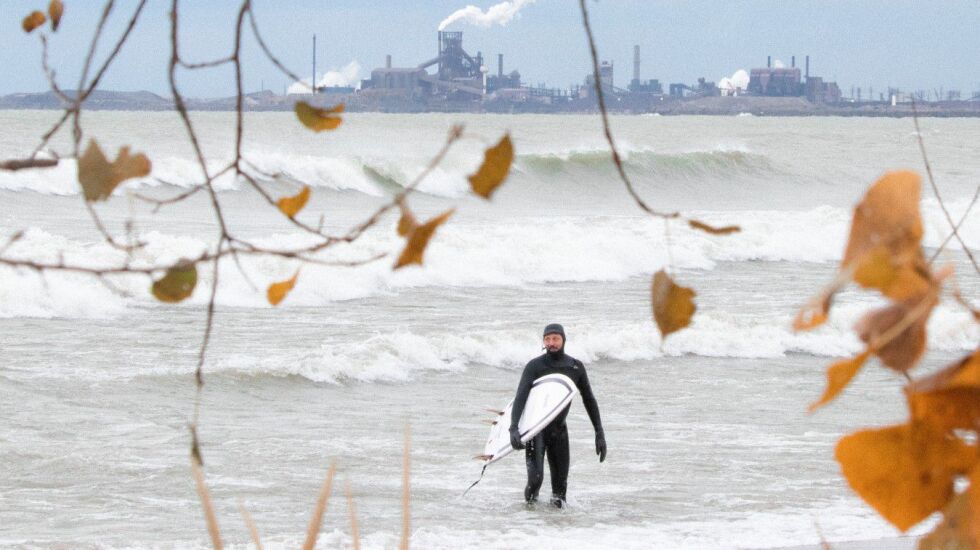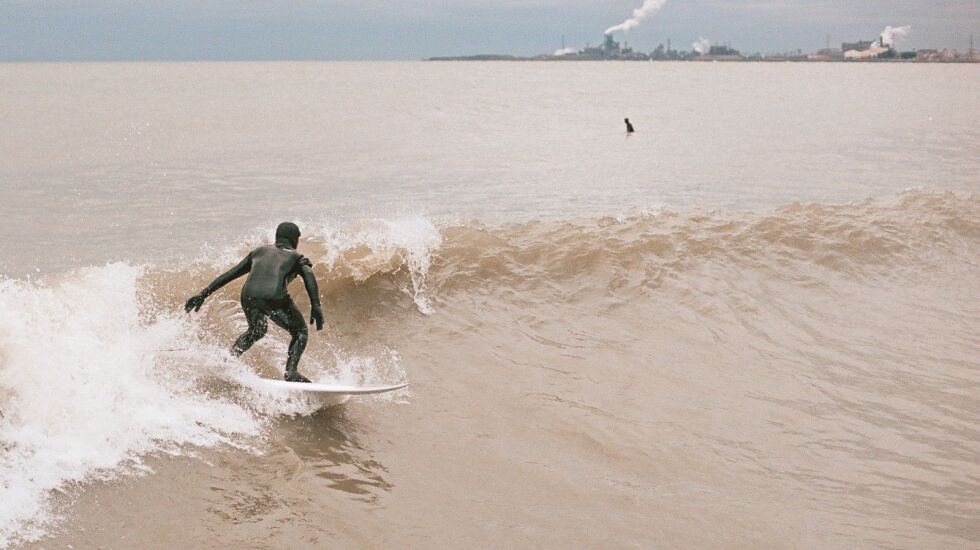
Lake Michigan was the consistency of a Slurpee. But that didn’t stop Pat Noyes from trying.
On a below-zero day one winter not long past, with a stiff wind churning up five-foot waves, Noyes headed to Greenwood Beach in Evanston.
Clad in a thick, black wetsuit, he clambered over the treacherous shelf ice that covered the beach like an Ice Age glacier. He slid into the water and paddled out, duck-diving under waves that broke and crashed over him.
Just yards from shore, his 10-foot surfboard leash got hung up on a piece of ice, and he couldn’t get it loose. He sat on his board, bobbing in the churning waters as a friend watched helplessly from shore.
Many times, Noyes has sought and found the exhilaration and menacing beauty of winter waves on Lake Michigan.
On the Great Lakes, after all, a surfer has to pick his spots. Good waves don’t come along every day.
Driving through blizzards, gusting winds, super-chilled water — these are the things that warm the heart of a “laker.” For winter surfers on the Great Lakes, bad is almost always good. The worse the weather, the better the surfing.
“I don’t think of it as treacherous,” Noyes says. “I think of it as an adventure.”

Noyes first tried surfing on a family vacation in Kauai, site of some of the sport’s most exciting surfs. But this is Chicago, and there’s no “Banzai Pipeline” or “Jaws.” And six months out of the year, it’s some version of cold. So he’s got to make the best of it.
“It’s always worth it,” Noyes says. “I’ve never gone in the lake during the winter and wished I didn’t.”
Even when he gets skunked.
Midwesterners surf Lake Michigan because it’s there. They surf in the winter because it’s best.
Surfers around Chicago are a tight-knit clan of construction workers, artists, autoworkers, engineers and even retirees — all waiting for storms to spin up at the top of the 320-mile-long Lake Michigan and for the swells to build down south.
With an eye on their weather apps, they stay ready, they stay in contact — and they try to not attract the attention of authorities when they drop everything and head out for undisclosed locations.
In the words of Mike Turnipseed, an Indiana old-timer and retired machinist featured in Noyes’s 2016 documentary, winter lake surfing requires “patience, dedication and preparation.”
“Surfing tends to ruin your life,” Noyes says, joking. “In particular surfing on the Great Lakes. It is such a demanding thing.”

The curative powers of cold-weather surfing
Mike Calabro, a freelance photographer, grew up in Ground Zero for winter surfing, in Whiting, Indiana, where the wind, swells and waves end their Lake Michigan journey.
Whiting is in the belly of the lake’s southern tip, which covers about 50 miles of shoreline roughly from the South Side curving through the Indiana Dunes to New Buffalo, Michigan. The town of 4,500 residents is home to BP’s largest oil refinery and is sandwiched between two of the country’s largest steel mills and the Horseshoe Hammond casino.
This is Southend Surf Club turf, discovered by a handful of surfing pioneers who organized that informal group almost 30 years ago. They weren’t your stereotypical West Coast surfer bums. They were men who worked in the building trades and plants all over the Calumet industrial region.
Like some of his surfing pals, Calabro was a teenage skateboarder. Driving past the Museum of Science and Industry on trips to Chicago to visit his dad, he saw people surfing. He didn’t own a surfboard, but, at 14, traded a skateboard for one.
His stepfather lent him an ancient neoprene wetsuit that Calabro describes as a “Jacques Cousteau aqualung” for its bulk and weight. Calabro could barely move in it, and he never managed to stand up on the tiny board.

Fortunately for his surfing interest, his family moved to the Bay Area when he was in his 20s, and he ripped surf in the Pacific Ocean for the next few years.
“It just got more and more addicting,” Calabro says.
When his mother needed care in 2003, he came back to Chicago, living out of a van and planning to stay a couple of years.
Almost 20 years later, he’s still in Andersonville and part of the Southenders, a group that includes his partner Maureen “Mo” McFadden, a nurse who is the rare female surfer,
“It’s a bit of a boy’s club, for sure,” McFadden says. “I love stealing all of their waves.
“I’m just out to play and share a beer with friends. They are some of the best days of your life.”
Despite road trips out West to surf, the two say they can’t shake a “special connection” with the lakes. Calabro describes a feeling of camaraderie, of “going to war together” against an unforgiving foe, surviving and bonding.
“It’s like that feeling of invincibility,” Southender Mike Killion said in the 2019 short film “Surfing the Rust Belt.” “You feel like you can conquer anything.”

There are hazards, starting with the ever-present danger of hypothermia.
Also: getting plowed by other surfers, crashing into floating ice chunks, getting arrested for trespassing or unlawful surfing, ear, eye and urinary tract infections, wetsuit rash, ice cream headaches from frigid water and dealing with pollution from nearby mills and refineries.
And when the graupel — supercooled water droplets — pelts your frozen face, “It sucks,” Calabro says.
He says sometimes he thinks: “Holy crap, what the hell are we doing out here?” But then, he says, “You paddle back out and suffer some more.”
But they venture into this hellscape for a reason. In winter, the storms are more intense and frequent. The water is denser, mimicking some of the buoyancy that saltwater affords. Best of all, there aren’t any crowds to steal your wave or get in the way.
For Calabro, cold-water surfing has been a cure for bouts of depression during long, dark months of winter. He says gettng out there “awakens” him.
“All the cold and discomfort is gone, and there is just the pure joy of playing,” Calabro says. “All the troubles go away. You catch a wave, and all that goes away.”
An ‘outlaw’ sport
Winter surfing entails a mix of science, friends and flexible schedules.
The science starts with having the right gear. The Great Lakes surfing season used to end in October. But advancements in fabric that have resulted in thicker and more flexible wetsuits have made it a year-around sport. A wetsuit works by trapping a thin layer of sweat to insulate the skin and conduct heat around the body. Only the surfer’s face is exposed, creating a genre of Instagram “ice beard” shots. A six-millimeter hooded suit, twice as thick as normal, with booties and gloves, runs about $500. That’s enough for a couple of hours on a board for experienced surfers.
The coldest part of winter surfing comes after you leave the water and, in the parking lot, are trying to peel off your skintight wetsuit as quickly as possible.
That’s where friends come in — to help.
Strategies for staying warm include pouring a thermos of hot water into the booties or gloves to warm the extremities or even relieving yourself in your wetsuit, Calabro says.
Knowing where to go means becoming an amateur meteorologist and having all of the right weather apps. The Third Coast Surf Shop, owned by Southend mainstay Ryan Gerard, features a web dashboard of weather info curated by a professional meteorologist known as “Dr. Fresh” (given name Ed Russo). It displays a color-coded ranking system, from best to worst waves, as well as wind speed and direction, barometric pressure, readouts from buoys on the lake and live webcam views.
“When I was starting out, you’d have to read the weather in the newspaper,” says Jack Flynn, 50, a Chicago artist. “You’d have to drive four hours, and you’d get there, and it sucks.”
What makes a good spot depends on the contours of the lake bed, like whether it’s been dredged for ships. Above-water structures like jetties, piers and breakwalls can help form clean waves by blocking east-west winds and creating protected alleys. Surfing begins with waves only a couple of feet high, but top locations might have head-high waves that carry a surfer 100 yards.
But finding choice spots isn’t easy for those not in the know. And access can be tricky, with fenced-off industrial plants and public lands like the Indiana Dunes that have controlled access.
With semi-secret locations known only to a tight-knit group, surfing in the Southend retains the aura of an outsider, or even outlaw, sport.
Flynn and Rex Flodstrom, a children’s book author and illustrator, were arrested years ago for surfing in Chicago. Both spent a few hours in jail — Flynn in his wetsuit. Flodstrom’s 2012 case was dismissed after he became a minor social media cause célèbre and attracted the interest of pro surfer Kelly Slater.
The city of Chicago legalized surfing at several beaches at the behest of the Chicago chapter of the Surfriders Foundation in 2009. Those beaches include Montrose, 57th Street, Rainbow and Osterman in the spring, fall and winter.
Yet Flynn was flagged down by a police officer this past year while surfing off 57th Street Beach.
Southenders says surfers are an asset, having made dozens of rescues of hapless swimmers over the years.

The Southend surfers want to make surfing a little less outlaw and a lot more clean. They kept getting sick surfing and even emerged smelling like gas in the waters of the Calumet industrial area, according to surfer Steve Arnam, a retired marine biologist and Surfriders Foundation consultant. After a series of toxic spills, the Surfriders chapter worked with others to get U.S. Steel to agree in 2021 to improve its wastewater monitoring and treatment.
In spite of the hazards, the winter lakers are here to stay. Last October, more than 70 competitors traveled to Whiting for the “Lakers That Rip Surf Jam” contest sponsored by Third Coast. Winners got driftwood prizes.
“I’ve surfed all over the world,” Noyes says, “just chasing waves. I always get pulled back to the Great Lakes.
“You feel a connection with everybody because there is so few of us. In California, in Hawaii, you’re just another surfer.”







